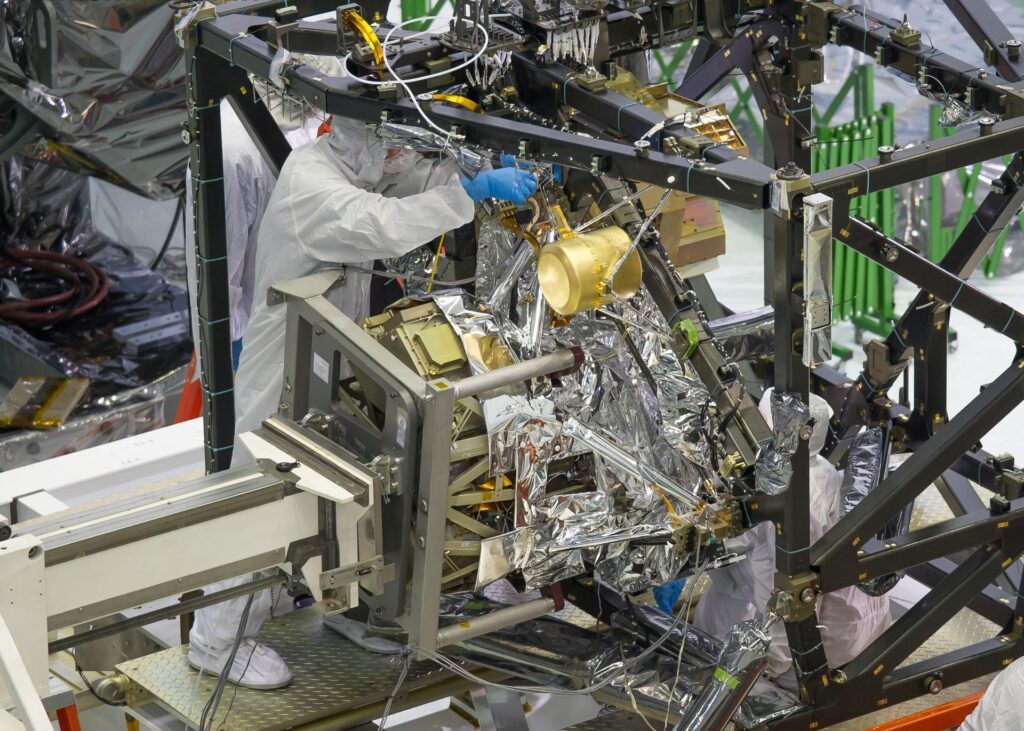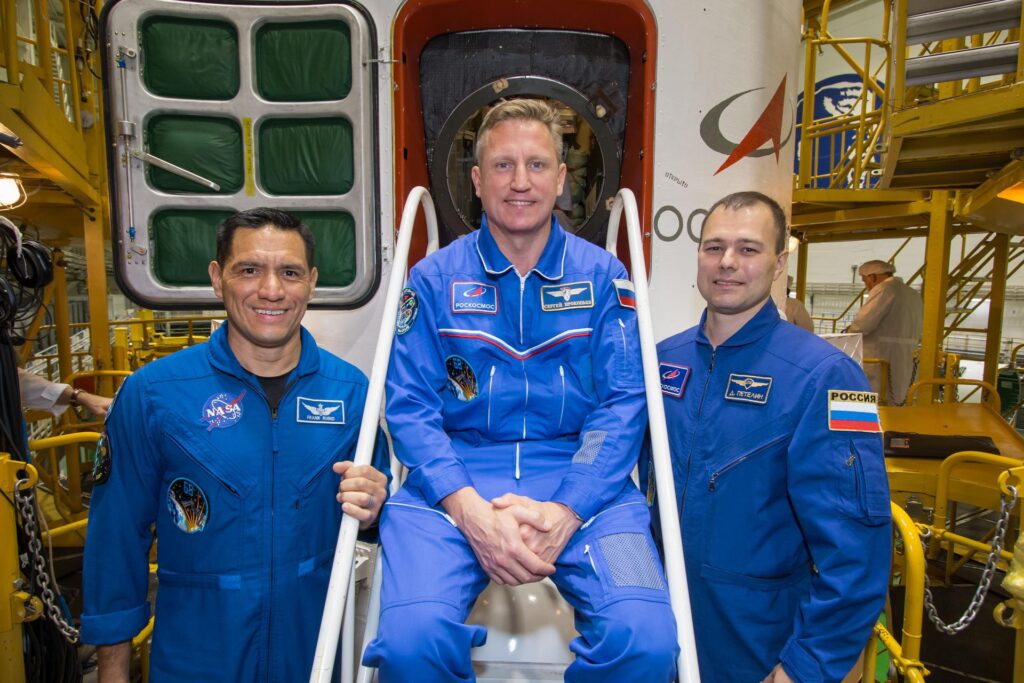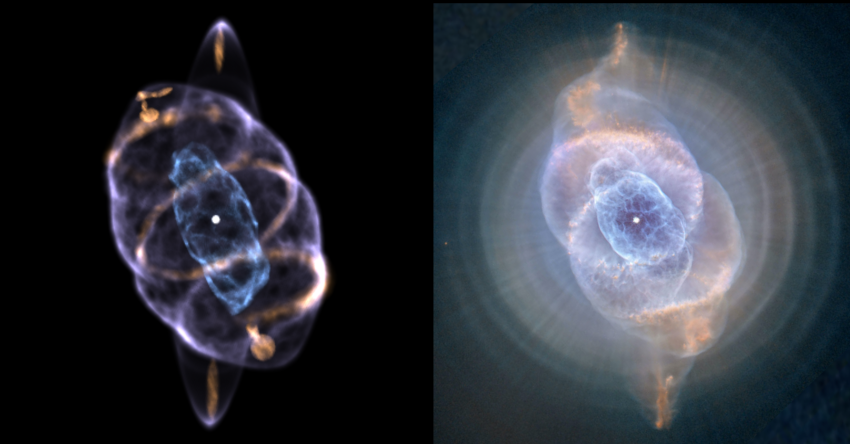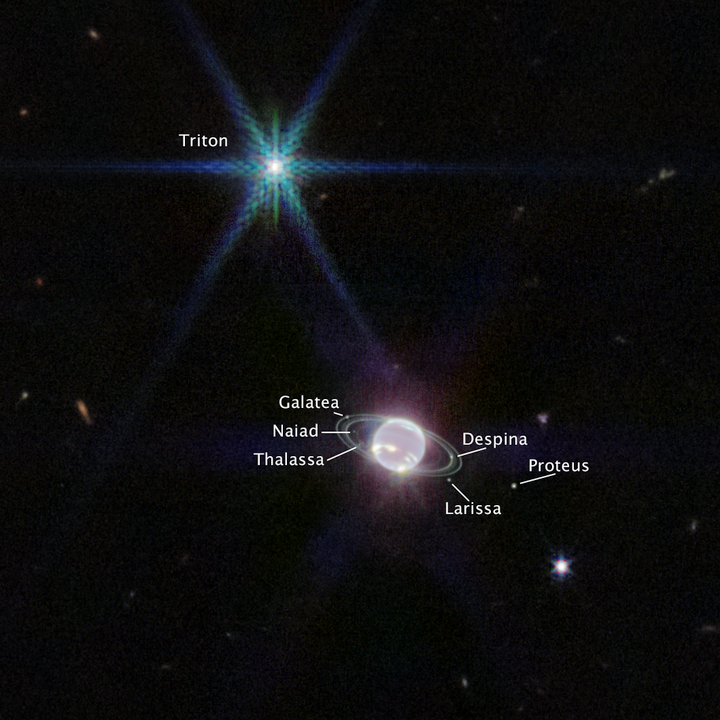In advance of the next scheduled launch attempt, NASA conducted another test to fill the fuel tanks onboard the Space Launch System rocket. The results were mixed, but the launch is still on schedule. Plus, a crewed launch, beautiful images, and an interview with Mike Simmons from Astronomy for Equity about sending telescopes to underprivileged students.
Podcast
Show Notes
JWST instrument has issues
- Mid-Infrared Instrument Operations Update (NASA Blogs)
- JWST Mid Infrared Instrument (JWST)
- MIRI Spectroscopic Elements (JWST)
150th Soyuz spacecraft heads to ISS
- New Crew Launching to Station Live on NASA TV (NASA Blogs)
- New Crew Enters Station and Begins Six-Month Mission (NASA Blogs)
NASA tries tanking SLS again
Take a 3D virtual hike through Jezero crater
- EPSC press release
Cat’s Eye Nebula imaged in 3D
- RAS press release
- “Morphokinematic modelling of the point-symmetric Cat’s Eye, NGC 6543: Ring-like remnants of a precessing jet,” Ryan Clairmont, Wolfgang Steffen, and Nico Koning, 2022 September 15, Monthly Notices of the Royal Astronomical Society
Scientists discover meteor impacts with InSight lander
- NASA JPL press release
- University of Maryland press release
- “Newly formed craters on Mars located using seismic and acoustic wave data from InSight,” Raphael F. Garcia et al., 2022 September 19, Nature Geoscience
JWST captures stunning image of Neptune
- Webb Telescope press release
Bringing telescopes to students in Libya
Transcript
Research, like life, is full of ups and downs. That’s fine.
Rocket science, like life, is also full of ups and downs, and that is sometimes less fine.
In this episode, Erik Madaus is going to take a look at the Artemis rocket’s not entirely perfect dress rehearsal that NASA ran before its Tuesday launch attempt and a problem that that is one heck of a downer with one of JWST’s instruments.
Following that, we’re going to go to our happy place and cheer on launching astronauts, look at stunning imagery, and Beth Johnson brings us an interview with Mike Simmons: the man looking to make sure no kid loses out on the chance to look through a telescope.
All of this and more, right here on the Daily Space.
I am your host Dr. Pamela Gay.
And we’re here to put science in your brain.

We keep talking about all the cool stuff the JWST is doing with its instruments. One of the more important instruments is the Mid Infrared Instrument MIRI, a combination camera and spectrograph which supports four modes – imaging, imaging with a coronagraph, low-resolution, and medium-resolution spectroscopy. MIRI has its own dedicated cryocooler to ensure a cold enough temperature for the very sensitive imagers to not pick up their own heat.
To switch between all of these modes, MIRI has three selectable wheels – one with filters for the imager and two with different filters and gratings for the spectrograph. A spectrograph splits the light coming from a target into its individual parts, creating a spectrum that can then be analyzed to determine the chemical makeup of the object. Combined with the coronagraph, this technique has already been used to identify the atmospheres of exoplanets.
All of the pieces of the instrument are working. However, one of the grating wheels used for medium-resolution spectroscopy is not functioning properly. On August 24, the instrument was moving a grating wheel to get ready for another observation, and the operations team noticed that the movement was slower than expected. Whatever has increased the friction for the wheel is a cause for concern, and NASA assembled an anomaly review board on September 6. In the meantime, JWST will not do observations requiring this mode.
We hope the issue is easily resolved.

In a sign that international cooperation isn’t completely dead, Soyuz MS-22 launched from Kazakhstan carrying an American astronaut and two Russian cosmonauts to the International Space Station (ISS) in the early morning of September 21.
Russian cosmonaut Sergei Prokopyev was the only experienced member of the crew as well as the Soyuz Commander. For the other two astronauts – NASA’s Frank Rubio and Roscosmos’s Dmitry Petelin – this was their first trip into space. Dr. Rubio was selected as an astronaut in 2017. Dmitry was selected in 2012.
Three and a half hours after launch, their Soyuz autonomously docked to the Rassvet module on the nadir or Earth-facing side of the Russian segment of the station. The crew will stay on the ISS for the standard six-month rotation before returning home. The crew they replace – Soyuz MS-21 – will come back a week after Soyuz MS-22 arrives. The total crew on the station will therefore be ten, temporarily.
In further good news, the next NASA crew rotation on SpaceX’s Crew Dragon, Crew 5, is currently scheduled for early October of this year and will have a Russian cosmonaut Anna Kikina on board. She will become only the fifth Russian female professional astronaut, the sixth Russian woman overall to go into space, and the first Russian to fly on an American spacecraft since STS-113 in 2002.

September 21 was a very busy day for NASA’s PR team, as NASA conducted another tanking test of the SLS rocket. This test was not a launch rehearsal but focused entirely on loading the vehicle’s Core Stage and second stage with propellant ahead of a possible launch attempt early next week.
Exactly like last time, liquid hydrogen fueling was stopped after only a few percent when a leak at the same seal between the ground and rocket. Unlike last time, they used a new procedure to load the very cold propellant extremely slowly into the rocket under low pressure, before ramping back up gradually. The goal of the new procedure was to keep the seal happy, which worked well, and the core stage was fully tanked and moved to replenish while maintaining a 0.5% concentration of hydrogen inside the umbilical.
Partway through the tanking process, the kickstart bleed on the hydrogen side was completed on all four engines. This procedure also caused problems during previous countdowns. During the bleed, the pressure on the seal increased, but the leak remained below the 4% limit.
Once both tanks were full, the test team decided to proceed with filling the upper stage. After that process was completed, another chill down of the engines occurred, this time at higher pressure to fully prepare the rocket for a flight. Both objectives were completed.

Overall, the cryogenic loading test was a mixed bag. Some of the problems recurred and then fixed themselves for reasons the team doesn’t yet understand, so now they need to look at the data. Meanwhile, the fix they performed… worked as expected. The new liquid hydrogen loading procedure kept the seal tight and the leak mostly within limits. The team even pressurized the stage and got the engines ready for flight using the systems at launch pad 39B for the first time.
Other procedures which had worked before had problems this time. The launch team got all they wanted to do done, but they would have scrubbed a launch attempt because of a slightly high hydrogen concentration that they ignored during this test. That concentration would have caused an immediate abort for the day.
So far, September 27 is still on the table for the next launch attempt, but they still have not received their Flight Termination System battery waiver from the Range. Another major concern is the time needed to safe the vehicle and get it back into the VAB if (when) a hurricane comes close to Florida. The team needs about four days for all that work. Hurricane Fiona is, fortunately, curving away from the U.S., but there will be other storms. This is Scrubtember, after all.
Coming up next, we have fantastic new images from several different spacecraft and, later on, Beth will interview Mike Simmons from Astronomy for Equity about how we can help send telescopes to underprivileged students.

One of the greatest frustrations of the last many decades for many an astronomer and planetary scientists is the bandwidth with have with our robots. While it has been possible since Opportunity and Spirit landed in 2004 to build 3D imagery that mirrors exactly what a human on Mars would see, we just haven’t had the literal bandwidth to rover the rovers around taking video and then get all the data back to Earth in a rational period of time.
So we live with animated 2D gifs and move on.
But what we can’t do with a video camera, researchers are starting to figure out how to do from space. By combining images from the orbiting Mars Express and Mars Reconnaissance Orbiter with altitude measurements, researchers have built a 3D interactive map that lets you fly around like a drone and explore Jezero crater.
This is not the final, VR-ready experience of my dreams, but it shows we’re getting there. It gives me hope that I won’t be retired before I can explore Mars with a tiny helicopter’s eye view as I look for fossils in the outcrops. My dream remains alive.
This work is presented at the European Planetary Science Congress by SHG Walter and their team.

With the drop in price of VR headsets and advances in computing, 3D exploration of astronomical objects is becoming a cool new possibility that lots of folks are trying to figure out how to take advantage of. This includes school kids. Secondary school student Ryan Clairmont has recently processed Hubble images of the Cat’s Eye Nebula and combined them with information on motion derived from spectra taken at the San Pedro Martir National Observatory in Mexico. Like a cop’s radar gun, these spectra reveal motion.
Clairmont combined this data to create the first 3D model of this system.
The Cat’s Eye nebula is a structure of gas and dust formed by a dying star that was exhaling its atmosphere. This system also appears to have had temporary jets that blew their own details into the structure.
We have linked the hi-res models to our website, and rather than describe them here, just go look on DailySpace.org. They’re stunning.

Earlier this week, Nature Geoscience published a new paper detailing how marsquakes detected by NASA’s InSight lander on Mars were the result of meteor impacts on the red planet.
The first of these confirmed impacts occurred on September 5, 2021, shattering into at least three large pieces that each made a crater. To confirm the strike, NASA’s Mars Reconnaissance Orbiter flew over the possible impact site and took pictures with the black-and-white Context Camera. Three new dark spots were photographed, so the next pass, they used HiRISE to capture high-resolution color images.
Of course, now that scientists had one example of what a confirmed impact looked like, they began combing through all the data. So far, they have found three other impacts that occurred between May 2020 and August 2021, and they think there are even more to be found.
And while Mars’s atmosphere may be much thinner than Earth’s, that atmosphere still exists, which means sound waves travel. NASA has included a sound file of the September 2021 event, which we’ll link to in our show notes.

We’ve already mentioned once this week that JWST has been tracking objects within the solar system as well as without. To date, we’ve seen stunning infrared images of Jupiter and Mars, but the latest image may be the best. JWST captured the ice giant, Neptune, in all its glory. Not only do you see the pearlescent glow of the icy world in the infrared, but the ring system is also clearly visible. The image also includes some faint dust bands and seven moons including Triton.
Honestly, I’m getting a little teary-eyed over these new images. We’ll have links to the entire set in our show notes at DailySpace.org. Go enjoy the wonder.
And now, let’s turn to Beth for this week’s interview on how we can help students in Libya get telescopes.
Interview
Joining us today is Mike Simmons, the founder of Astronomy for Equity, an Affiliate Research Scientist at the Blue Marble Space Institute of Science, and a member of the Board of Directors for the International Dark-Sky Association. Mike is here to talk with us about a new crowdfunding campaign to bring telescopes to astronomy outreach students in Libya.
Thank you for joining us, Mike.
Once again, thank you for being here today, and good luck with the crowdfunding campaign. We will have all the relevant links in our show notes at DailySpace.org.
This has been the Daily Space.
You can find more information on all our stories, including images, at DailySpace.org. As always, we’re here thanks to the donations of people like you. If you like our content, please consider joining our Patreon at Patreon.com/CosmoQuestX.
Credits
Written by Pamela Gay, Annie Wilson, Beth Johnson, Erik Madaus, and Gordon Dewis
Hosted by Pamela Gay, Beth Johnson, and Erik Madaus
Audio and Video Editing by Ally Pelphrey
Content Editing by Beth Johnson
Intro and Outro music by Kevin MacLeod, https://incompetech.com/music/


 We record most shows live, on Twitch. Follow us today to get alerts when we go live.
We record most shows live, on Twitch. Follow us today to get alerts when we go live.